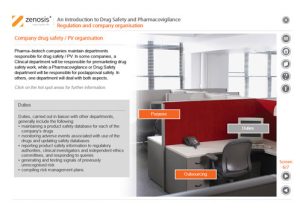An Introduction to Drug Safety and Pharmacovigilance
Course Summary
One of our most requested courses.
Organisations such as Merck, ICONplc, Incyte, Boehringer-Ingelheim and Roche utilise this module for their people.
Drug safety monitoring and risk management are vitally important for medicinal product developers, licence holders and clinical investigators. In addition to their duty to protect public health, increasingly tight regulation and potentially massive payments to litigants provide strong incentives for pharmaceutical and biotechnology companies to ensure that they maintain efficient systems for drug safety / pharmacovigilance and that all staff are aware of the basic requirements. This course will provide them with an overview of the most important aspects of this discipline, both before and after marketing of products, especially as they apply in Europe and the USA.

£149.00 Original price was: £149.00.£139.00Current price is: £139.00. exc. VAT
Purchasing Information
When you have completed your course order, Zenosis will finalise the setup of your course materials and contact you on the email address that you provide in your order. You can expect this process to be completed within one business day (using the UK business calendar) of completing your payment.
It is therefore essential that you use your real email address for your order, or indicate in the purchase notes the email address to be used for the course set-up, and check that any messages from Zenosis or grapl are not lost in your junk or spam folder.
You will have access to the course module(s) for a period of 180 days after your purchase is complete.
Detailed Course Information
• Explain, with examples, why drug safety monitoring / pharmacovigilance is necessary.
• Describe ways in which drug safety / pharmacovigilance is regulated nationally and internationally, and identify international policy-making bodies.
• Outline how drug safety / pharmacovigilance responsibilities are organised within pharmaceutical and biotechnology companies.
• Sketch how a product safety database is compiled, how a product’s safety profile is assessed, and how safety information is included in documentation for regulatory authorities, healthcare professionals, and consumers.
• Apply appropriate terms to describe different types of adverse effect.
• Specify requirements to report adverse reactions to regulators.
• Outline requirements for safety data and for risk management plans in applications for marketing approval.
• List tasks involved in monitoring adverse reactions to marketed products, and sketch how safety signals are detected and tested.
• Identify factors that influence the evaluation of a product’s benefit/risk balance, and list actions that may be taken in response to changes in the balance.
Entry-level staff, and those seeking a refresher, in drug safety / pharmacovigilance and clinical departments will find the course invaluable, as will clinical investigators and other healthcare professionals. Staff in other departments of pharmaceutical and biotechnology companies will benefit from taking the course to gain an appreciation of the basics of the subject.
• Module overview
– Describes what the course is about, sets out learning objectives, defines key terms and provides a brief overview of course content.
• Regulation and company organisation
– Explains the rationale for modern drug safety / pharmacovigilance (PV) regulation and practice, describes international policy-making bodies and sources of regulatory guidance, and outlines company drug safety / PV organisation, product safety databases and core safety information
• Before a product is marketed
– Sets out the fundamentals of pre-marketing drug safety / PV: safety information for investigators, describing adverse effects, clinical trial reporting requirements, safety data in marketing applications, risk management planning, and product information.
• After a product is marketed
– Sets out the fundamentals of post-marketing PV: monitoring adverse drug reactions, licence holders’ reporting requirements, detecting and testing safety signals, assessing benefit/risk balance, risk minimisation, communicating new safety information, product withdrawal.
• Quality system, inspections and audits
– Describes measures, increasingly emphasised by regulators, to ensure adequate performance of a PV system: the organisation’s PV quality system, regulatory inspections, and audits.
• Review and further information
– Summarises key points and provides links to important guidance documents and other reference sources.
• Assessment
– Multiple-choice mastery assessment.
